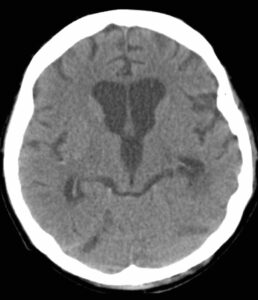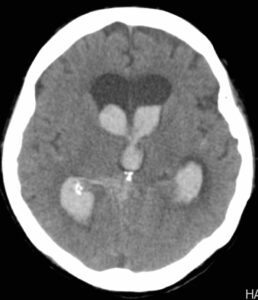Intraventricular Hemorrhage (IVH) is an accumulation of blood within the ventricular system that may occur spontaneously (from hypertension, blood thinners), from tumors or vascular malformations or as a result of a surgical intervention. IVH may obstruct the normal flow and reabsorption of cerebrospinal fluid and cause hydrocephalus. Treatments include external ventricular drainage, ventriculoperitoneal shunting, and instillation of the potent blood thinner Tissue Plasminogen Activator (TPA) directly into the ventricular system (Figure 1, 2). Over time the coagulum is metabolized by the body; an assessment of the status of CSF reabsorption is then undertaken to anticipate symptomatic hydrocephalus.

Figure 1
Top row: Axial CT demonstrates an extensive intraventricular and subarachnoid hemorrhage on day of admission with associated hydrocephalus. Bottom row: Demonstrates near complete resolution of IVH after four doses of intrathecal tissue plasminogen activator (TPA).


Figure 2
Images obtained before and after treatment of intraventricular hemorrhage with EVD and intraventricular TPA.

